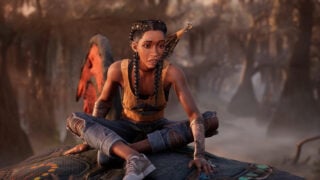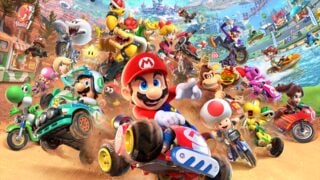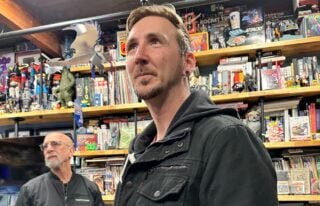South of Midnight mixes a beautiful setting with familiar gameplay, and that may be for the best
Compulsion Games’ third title might benefit from not trying to be too clever for its own good

When I wrote a preview of South of Midnight late last year, I concluded by saying that even though the game looked fantastic, the proof would always be in the playing.
After all, developer Compulsion Games has previously released two titles that boasted a wonderfully unique visual style but were somewhat lacking in the gameplay department.
2013’s Contrast was a visually striking puzzle platformer set in the 1920s, which took influences from burlesque, vaudeville, Belle Époche and Art Nouveau aesthetics.
Its clever world-shifting gimmick which had you moving between the 3D world and the 2D shadows it created was similarly impressive, but it didn’t translate particularly well to the actual gameplay and was a bit too frustrating as a result.
This was followed by We Happy Few, which grabbed players’ attention with its initial teaser trailer and its dystopian 1960s London setting, but also failed to live up to expectations when the final game was released.
When South of Midnight was first shown off at the Xbox Games Showcase in June 2023, then, my initial thought was “God, this looks fantastic”, but this was almost immediately replaced with another thought: “God, I really hope they can nail it this time.”
Recently I got the chance to go hands-on with a small section of the game and so far the initial signs are promising. From what I’ve played, South of Midnight doesn’t appear to be doing anything truly revolutionary beyond its art style, but given Compulsion’s past record it could be argued that playing it safe with the gameplay is a wise move.
My hour or so with the game was spent playing its third chapter, which takes place after protagonist Hazel has already seen her house swept away downriver by a hurricane, along with her mum inside it. Heading into the storm to look for her home, Hazel encounters Mahalia, a ghost who teaches Hazel special abilities.
The chapter opens with Hazel encountering a giant catfish hanging from a tree – the same one you may have seen in previous trailers and gameplay footage from the game – so it’s up to Hazel to figure out a way to get the catfish down by exploring the nearby environment.
Naturally, given that this is an action platformer, a lot of this exploration results in fights against groups of enemies, which in this instance are mysterious tar-like creatures called Haints, which have been plaguing the world with dark energy.
Hazel is a weaver, which means she can use magical powers to combat this dark energy. By fighting them, the player isn’t actually carrying out violence (even though it certainly looks that way) but is instead using Hazel’s weaving powers to mend their dark energy.
After weakening stronger enemies, Hazel can walk up to them and use a special unravelling finishing move which essentially pulls out their darkness and yanks them out of existence. Unravel all the enemies in a section and that particular area will be coloured with greenery. It’s like Flower with fighting, basically.
Because my preview time started with Chapter 3 it’s not clear how much gameplay is in the first two, but I’m inclined to believe it’s not much because Hazel is still learning new moves throughout the course of the third chapter.
This includes a double-jump move, a glide move which sees her briefly weaving a Breath of the Wild style paraglider in mid-air, and a wall-run technique which comes in handy near the end of the stage when she’s being pursued by a large creature. Again, none of this is anything you won’t have already seen countless times in other action platformers, but it’s handled well here.
Controlling Hazel is a breeze and her double jump and glide moves are quite generous, allowing players to cover large areas with ease. No doubt later stages will have more treacherous terrain but there’s something very satisfying about swiftly hopping through its Deep South environment, stopping only to dish out the occasional kicking and unravelling to any enemies in your way.
“No doubt later stages will have more treacherous terrain but there’s something very satisfying about swiftly hopping through its Deep South environment, stopping only to dish out the occasional kicking and unravelling to any enemies in your way.”
The section I played also hinted at some of the game’s focus on Deep South folklore, and introduced me to its first Mythical Creature, called Benjy. As you play through the third chapter you encounter Rhubarb, a troubled young man who asks you go out with a bottle and try to bottle the clumps of pain that are dotted around the area.
These pain clumps are each symbolised by a brief cutscene, played out by ghost-like figures, telling the story of Rhubarb’s brother Benjy and how he was treated badly by others. As you see each part of the story, the illusion fills your bottle, and the aim is to plant the bottle in a bottle tree once it’s full and hopefully cure the pain.
It eventually turns out that Benjy’s story gets rather dark, and ends with you climbing a giant boy-tree hybrid that forms part of the stage’s final puzzle, leading to the eventual release of the catfish.
It’s little things like these interesting pieces of lore that will make South of Midnight stand out from other games in its genre, and it’s for this reason that Compulsion Games is perhaps playing it smart this time by taking fewer risks with the gameplay.

Contrast and We Happy Few were both games that attempted to do something different with their art style, but tried to carry that innovation into its game mechanics too and struggled as a result. Sometimes it’s possible to be too clever for your own good, and sometimes players need at least some sort of familiarity to ground them if other aspects of the game are original.
In this case, South of Midnight’s focus on the Deep South – an area of America that’s oddly underutilised in video games – coupled with its interesting stop-motion animation style of its characters, may be all the innovation the game needs.
If, at its core, it continues to offer a straightforward action platformer, then its setting, plot and art style may be the elements that elevate it above other typical examples of the genre. Sometimes it’s fine for the journey to be a simple one, if the scenery along the way is what catches your eye.
Of course, this was a one-hour bite of what will hopefully be a much larger game, and so if South of Midnight doesn’t go on to mix up either its setting or its mechanics, there’s a risk it may eventually outstay its welcome before the credits roll.
So far things are looking very positive but – if you’ll forgive me for bringing things full circle – when it comes to the full release on April 8, the final proof will, as ever, be in the playing.




















